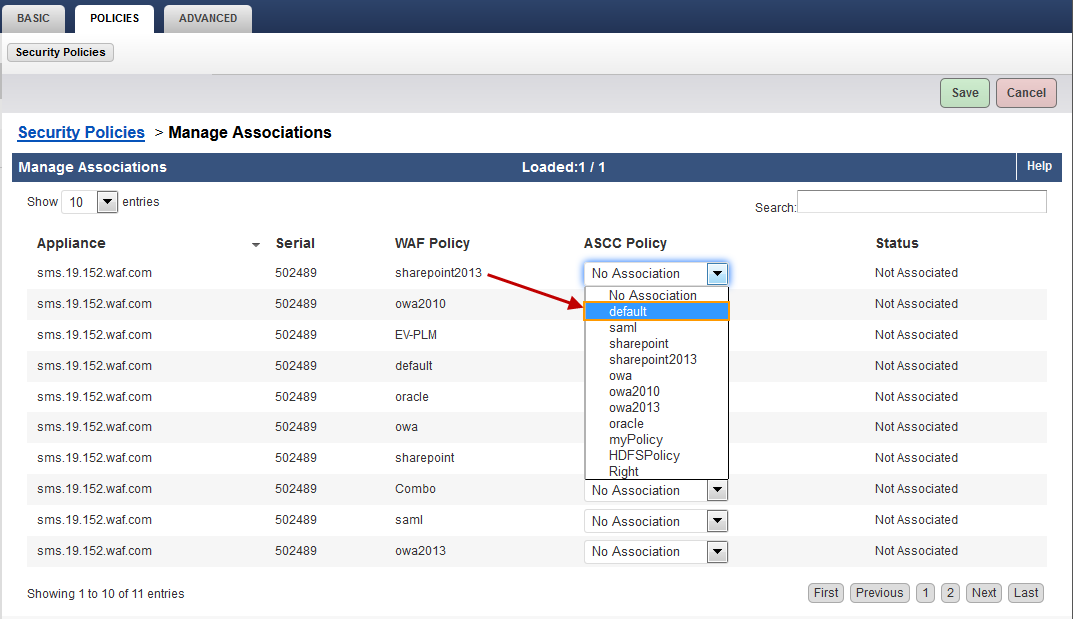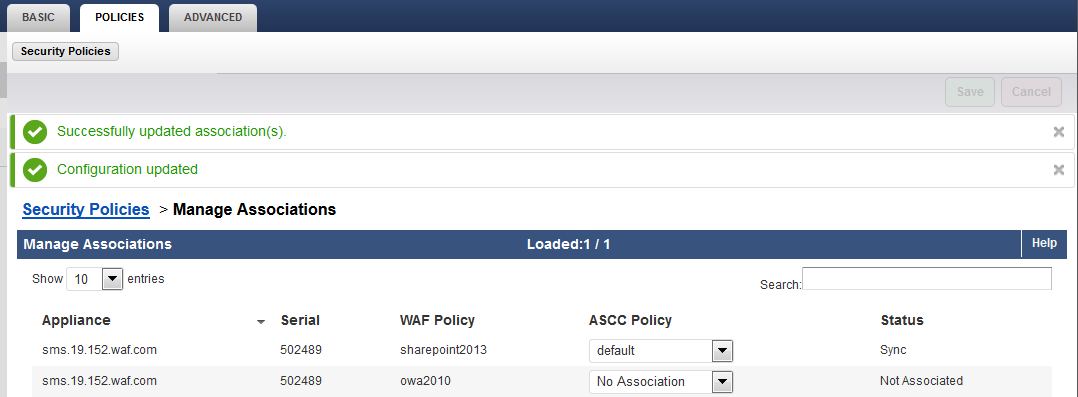Overview
The Barracuda Web Application Firewall Control Center enables you to configure settings and share it with the connected devices. To share the configuration, you must first associate the object on the Barracuda Web Application Firewall Control Center with the object on the Barracuda Web Application Firewall device.
Understanding How the Shared Configuration Works
In this section, we use the object “Security Policy” as an example to explain how the configuration is shared between the Barracuda Web Application Firewall Control Center and the connected devices.
Initial Connect to the Barracuda Web Application Firewall Control Center
The Barracuda Web Application Firewall Control Center includes a predefined set of security policies. When the Barracuda Web Application Firewall is connected to the Barracuda Web Application Firewall Control Center, the configuration settings of the security policies on the connected device will automatically be overridden with the Barracuda Web Application Firewall Control Center configuration. This configuration synchronization happens because the Association Mode for the connecting devices is set to Automatic by default on the ADVANCED > Settings page. If you intend to manually associate the Barracuda Web Application Firewall Control Center security policies with the connected device, set the Association Mode to Manual before connecting the device.
For information on how to connect a device to the Barracuda Web Application Firewall Control Center, see Connect a Device section in the Connecting and Disconnecting Devices article.
Association Mode
The Association Mode determines whether to synchronize the configuration settings automatically or manually with the connected devices at the time the device is first connected to the Barracuda Web Application Firewall Control Center.
- Automatic – The security policies on the Barracuda Web Application Firewall Control Center will automatically be associated with the security policies of the connected device, and the Barracuda Web Application Firewall Control Center overrides the configuration of the security policies on the device with its configuration
- Manual – You should select the security policies and the devices to which the configuration needs to be synchronized.
Creating a New Security Policy
The Barracuda Web Application Firewall Control Center provides a predefined set of policies that can be modified and applied to the connected devices. Additionally, you can create a new security policy and synchronize it with all connected devices, or associate the policy with the specific device(s) and synchronize the configuration. Perform the following steps to create and associate a new security policy:
- Log into the Barracuda Web Application Firewall Control Center web interface.
- Go to the POLICIES > Security Policies page.
- In the Create New Policy section, do the following:
- Policy Name: Enter a name for the policy.
- Based On: Select an existing security policy based on which you want to create a new security policy, or select Create New to create a new security policy with custom settings.
- Sync to All: Specify whether or not to push the policy to the connected devices.
- Yes – The policy gets created and associates with all connected devices.
- No – The policy gets created and will be listed in the Policy Manager section. In this case, you should manually associate the policy with the device(s) to synchronize the configuration.
- Click Add.
Synchronizing a Custom Policy with the Connected Devices
Perform the following steps to synchronize a custom policy with the connected devices:
- Log into the Barracuda Web Application Firewall Control Center web interface.
- Go to the POLICIES > Security Policies page.
- In the Policy Manager section, identify the policy that needs to be synchronized with the device.
- Select Sync to Device(s) from the Actions drop-down list next to the policy. The Sync to Device(s) page appears.

- In the Sync to Device(s) section, select the device to which you want to associate the policy and click Save.

- The policy gets synchronized with the selected devices.

Steps to Manually Associate an Existing Policy on the Barracuda Web Application Firewall with the Policy on the Barracuda Web Application Firewall Control Center
Perform the following steps to manually associate an existing security policy on the Barracuda Web Application Firewall with the Policy on the Barracuda Web Application Firewall Control Center:
- Log into the Barracuda Web Application Firewall Control Center web interface.
- Go to the POLICIES > Security Policies page.
- In the Policy Manager section, click Manage Associations. The Manage Associations page appears.

- In the Manage Associations section, identify the WAF policy that needs to be associated with the policy on the Barracuda Web Application Firewall Control Center.
- Select a policy from the ASCC Policy drop-down list next to the WAF policy, and click Save.


- After successful association, the Manage Associations section displays the ASCC policy that you associated with the WAF policy.

Modifying an Existing Security Policy
When an existing security policy on the Barracuda Web Application Firewall Control Center is modified, the configuration is automatically synchronized with the associated security policy(s) on the connected device(s). If the security policy is not associated with the connected device(s), the policy will be saved in the Policy Manager section until it is manually synchronized with the connected device(s).
To modify an existing security policy on the Barracuda Web Application Firewall Control Center, perform the following steps:
- Go to the POLICIES > Security Policies page on the Barracuda Application Control Center web interface.
- In the Policy Manager section, identify the policy that you want to modify, and select Edit from the Actions drop-down list next to the policy. The selected policy page appears with all the sub-policies associated with it.
- In the selected policy page, do the following:
- Revision Control: Mark the configuration changes as Major/Minor based on the number of changes/severity of changes. This will basically reflect on the sync version associated with the policy. For example, selecting Minor and modifying the request limit policy parameters would change the Sync Version from 1.0 to 1.1. If the same modification is done by setting the Revision Control to Major, the Sync Version changes from 1.0 to 2.0.
- Request Limits: The Request Limits policy defines the validation criterion for incoming requests by enforcing size limits on HTTP requests. The requests that exceed the defined length/limit are denied or allowed to pass through based on the Mode (Passive or Active) set for a Service. Modify the values if required and click Save. For more information, refer the Online Help.
- Cookie Security: The Cookie Security policy guarantees confidentiality of the cookie and avoids tampering of the cookie value. A shorter timeout interval can be configured for cookies to help minimize the chances of cookie stealing. This policy does not prevent cookie replay attacks. Modify the values if required and click Save. For more information, refer the Online Help.
- URL Protection: The URL Protection policy protects the service against web attacks. Modify the values if required and click Save. For more information, refer to the Online Help.
- Parameter Protection: The Parameter Protection policy protects the service against attacks based on parameter values. Modify the values if required and click Save. For more information, refer to the Online Help.
- Cloaking: The Cloaking policy prevents leakage of information about a Web site or service that is vulnerable for Web attacks. The HTTP headers and return codes are concealed before sending a response to a client. The response headers are filtered based on the headers defined in the Headers to Filter field. Modify the values if required and click Save. For more information, refer to the Online Help.
- URL Normalization: This URL Normalization policy secures the websites from path traversal attacks, and specifies canonicalization policies for URLs found in the requests. Modify the values if required and click Save. For more information, refer to the Online Help.
- Protected Data Types: The Data Theft Protection policy protects the sensitive information/data sent in responses from being exposed to unauthorized users. Modify the values if required and click Save. For more information, refer to the Online Help.
- Global ACLs: The Global ACL policy defines the strict access control rules. You can add a new URL ACL or modify the existing URL ACL. Modify the values if required and click Save. For more information, refer to the Online Help.
- Action Policy: The Action Policy is a collection of settings that determines the action to be enforced when a violation is detected. Modify the default attack action settings if required and click Save. For more information, refer to the Online Help.
Reconnecting to the Barracuda Web Application Firewall Control Center after Connection Failure
If the Barracuda Web Application Firewall disconnects from the Barracuda Web Application Firewall Control Center due to connection failure and reconnects to the Barracuda Web Application Firewall Control Center, the Barracuda Web Application Firewall Control Center validates the Sync Version with the connected device. If the Sync Version in the connected device is different, the Barracuda Web Application Firewall Control Center overrides the configuration on the connected device with its configuration. If the Sync Version is same, then the configuration is not synchronized with the connected device.
Disconnecting the Device Manually
When a device is disconnected manually, the Barracuda Web Application Firewall Control Center removes all the associations made with the device. If the same device is connected again with the Barracuda Web Application Firewall Control Center, it is treated as a new device and configuration synchronization happens based on the Association Mode (Automatic or Manual).
